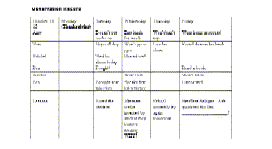
|
In order to gauge
their students effectively, teachers must have a clear, well-communicated plan
of assessment that incorporates a wide variety of assessment strategies.† Assessment has taken on quite a different
character over the years, with the advent of many new and authentic ways of
assessing individuals and groups.†
I have attempted to
use a variety of assessment strategies that incorporate the characteristics of
authenticity, diversity and efficacy.†
Fundamental to the assessment and evaluation of students is the
collaborative process.† As a teacher of
a variety of grades, I have found that students respond well to an environment
they can control.† Students do well when
they understand how they will be evaluated.†
Furthermore, students do extremely well when their teacher evaluates and
assesses them in an equitable, well-communicated manner.
 Artefact One
Artefact One

|
Accuracy: |
Visual Appeal: |
Completeness: |
|
All items are placed correctly within the
map (i.e. cities, rivers, landforms, etc.) |
The lettering is neat and the map is well
organized.† The appearance is
excellent and realistic. Symbols are used well. |
All relevant information is included (i.e.
scale, legend, etc.) The information is all up to date. |
|
Some
features are out of place, but most are correctly located. |
Some
elements of the map are difficult to read. The
style and decoration is not appropriate for a map. |
Most
important information is present. The
information is not obviously out of date. |
|
Several
features are out of place. |
Many
words and symbols are difficult to read or interpret. The
colouring and style make the map difficult to read. |
Several
important features are missing.† Some
information is clearly out of date. |
|
Some
features are missing and several features are clearly out of place. |
The
map is difficult to read. |
Many
important features are missing.† |
return to artefact links

|
Learning
Activities |
Fall
Object Sorting
|
Sorts by |
On task |
Shows persistence |
Group skills |
Fall
Walk
|
Collects right objects |
Walks safely |
Obeys Adults |
Rememberseeing |
||||||||||||
Attendance
|
Revise
skills
|
Attendance
|
Revise
skills
|
|||||||||||||||||||
|
Amy |
X |
No |
Colour |
Yes |
Yes |
Yes |
X |
No |
Yes |
Yes |
Yes |
Butterflies |
||||||||||
|
Tom |
X |
Yes |
Size |
Maybe |
Yes |
No |
X |
Yes |
No just toys |
Yes |
Yes |
Oak |
||||||||||
|
Satchel |
X |
Yes |
Colour |
N |
N |
maybe |
|
Yes |
|
|
|
|
||||||||||
|
Ben |
X |
Yes |
Kind |
Yes |
Yes |
No |
X |
Yes |
None |
Runs |
No |
sparrows |
||||||||||
|
|
|
|
|
|
|
|
|
|
|
|
|
|
||||||||||
|
|
|
|
|
|
|
|||||||||||||||||
Notes on the effectiveness of the activities (too difficult, too easy,† what concepts to develop, skills to develop) :
†Observation Record
|
October 10-13 |
Monday† (Thanksgiving) |
Tuesday |
Wednesday |
Thursday |
Friday |
|
Amy |
|
Doesnít put socks on |
Eats lunch for snack |
Wonít/canít nap |
Went home at recess! |
|
Tom |
|
Naps all day |
Wonít go to gym |
Lost his shoes |
Found them in his lunch |
|
Satchel |
|
Tied his shoes today |
Shared well |
|
|
|
Ben |
|
Fought! |
|
|
Read a book |
|
Satchel |
|
|
Wonít talk |
|
Wonít listen |
|
Ben |
|
Brought scat into class |
Speaks first full sentence |
|
Listens well |
|
|
|
|
|
|
|
|
Lessons |
|
Bored the children |
Alternate center invented by student they found it exciting.† WHY? |
School assembly try again tomorrow |
Excellent dialogue.† Ask questions like this ______ ___________________? |
return to artefact links